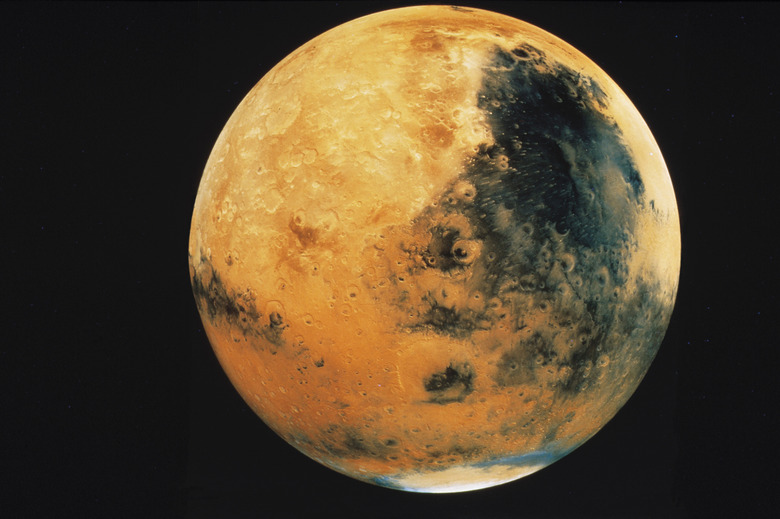The Weather On Each Planet
While the Earth is home to many different weather systems, the most extreme terrestrial conditions are mild compared to weather on other planets. All of the other bodies in the solar system large enough to maintain an atmosphere have their own weather systems, ranging from Earthlike to almost unimaginable. Humanity's exploration of neighboring planets is far from complete, but scientists can draw some conclusions about conditions on other worlds.
Mercury
Mercury's position closest to the sun leaves it with very little atmosphere due to the proximity of the nearby star. What thin atmosphere the planet does possess flows away from it like a comet's tail due to the powerful solar wind, without any discernible weather patterns.
Venus
Venus has an extremely dense atmosphere, layered with carbon dioxide and corrosive clouds. Its primary weather features are high winds and lightning storms high in the atmosphere, while the lowest levels remain calmer and extremely hot due to the planet's runaway greenhouse effect. Temperatures at the surface are high enough to melt lead, rendering even the hardiest landing probes inoperative within hours of touching down.
Mars
A number of probes sent to Mars have revealed much about the planet's weather patterns. Dust storms are the primary weather pattern on the planet, and while clouds of ice crystals occasionally form in the atmosphere, the pressure is too low for liquid precipitation. During the Viking II mission, frost regularly appeared at the probe's landing site during the Martian winter.
The Gas Giants
Jupiter, Saturn, Uranus and Neptune all share similar physical characteristics, as they are primarily made up of gases rather than solid matter and so share similar weather patterns. The gas giants all experience extremely high winds, hundreds of miles per hour at the equator. Storms in the atmosphere can last for extremely long times, such as Jupiter's Red Spot or Saturn's hexagonal storm at its north pole. Uranus has a unique tilt and rotation that freezes one portion of the planet for decades before it rotates back into the sunlight, triggering violent storms with the warming effect. Neptune's atmosphere features high cirrus clouds formed of methane that travel rapidly across the upper reaches of its atmosphere.
The Kuiper Belt
While Pluto may have lost its status as a full-fledged planet, it and the other objects in the Kuiper belt outside the orbit of Neptune remain targets for study. The limited observation that the U.S. National Aeronautics and Space Administration has performed on these planets suggests that their atmospheres are thin and predictably cold. Their extreme distance from the sun reduces the difference in temperature between the day and night sides, removing the temperature fluctuations that could help drive weather patterns.
References
- National Oceanic and Atmospheric Administration: Venus
- National Oceanic and Atmospheric Administration: Mars
- National Oceanic and Atmospheric Administration: Saturn
- National Oceanic and Atmospheric Administration: Jupiter
- National Oceanic and Atmospheric Administration: Neptune
- National Oceanic and Atmospheric Administration: Pluto
Cite This Article
MLA
Kazmeyer, Milton. "The Weather On Each Planet" sciencing.com, https://www.sciencing.com/weather-planet-3906/. 24 April 2017.
APA
Kazmeyer, Milton. (2017, April 24). The Weather On Each Planet. sciencing.com. Retrieved from https://www.sciencing.com/weather-planet-3906/
Chicago
Kazmeyer, Milton. The Weather On Each Planet last modified March 24, 2022. https://www.sciencing.com/weather-planet-3906/
